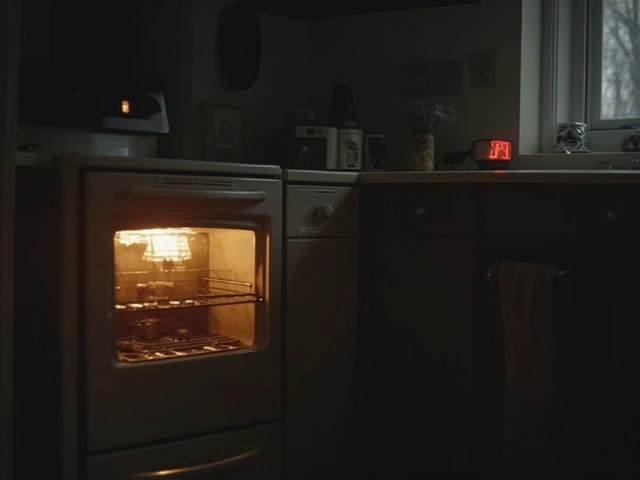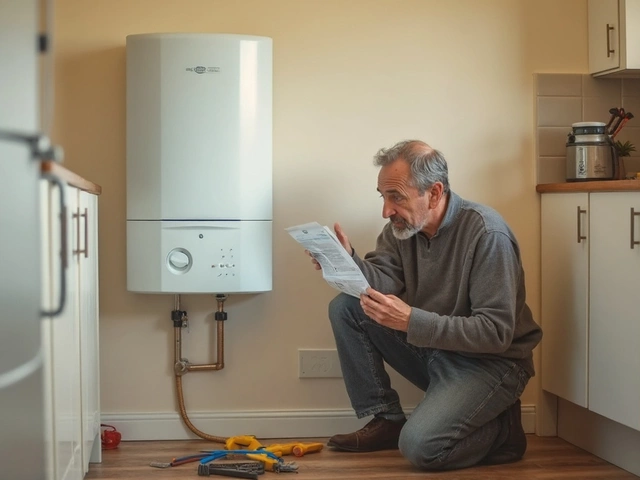Ever turn on your oven only to find it's as cold as your fridge? That's one of the most common oven complaints out there. Whether you love to bake or just heat up leftovers, a busted oven ruins your plans fast. From what I've seen—and fixed in my own kitchen—it's almost always something simple that brings your oven to a halt.
The most typical problems are things like the oven not heating up, uneven cooking, or buttons that don't respond. Sometimes, the issue is a tiny part, like a burner coil going bad. Other times, it's something bigger—a faulty thermostat or a broken fan. Knowing what usually gives out makes it a lot less stressful when things go south.
Before calling anyone, check the basics: Is it plugged in? Did a circuit breaker trip? Is the door closed all the way? These sound obvious, but you’d be surprised how often I’ve found my oven "broken" because someone (usually me or Maya) just didn’t push the door until it clicked.
- Why Ovens Break Down
- The Most Common Oven Problems
- DIY Oven Troubleshooting Tips
- When to Call a Pro
- Keeping Your Oven Running Smoothly
Why Ovens Break Down
Most ovens these days are pretty reliable, but like any appliance, they're made up of parts that wear out over time or run into trouble because of how we use them. It’s almost always either age, wear and tear, or a quick fix that gets overlooked. If you look at service call data, about 4 out of 10 oven repairs have to do with heating problems, and another chunk is down to electrical hiccups.
| Common Reason | Percentage of Oven Breakdowns |
|---|---|
| Heating Element Failure | 34% |
| Thermostat Issues | 20% |
| Faulty Igniter (Gas Ovens) | 16% |
| Electrical/Control Problems | 18% |
| Miscellaneous (door seals, fans, etc.) | 12% |
The biggest culprit? The heating element. It's the part that glows red or gets super hot. Over years of use, it can burn out or crack. For gas ovens, the igniter is usually to blame—it gets weak with time and stops firing the burner.
Then there's the thermostat. If your oven runs too hot or ice cold, it's usually because the thermostat’s not reading temperatures correctly. Electrical problems are also common—things like frayed wires, blown fuses, or dodgy control panels mess things up more than you'd think. Even something as simple as a loose connection can knock your oven repair plans off track.
- Ovens in homes with kids or heavy bakers tend to break a lot faster, mostly because of more frequent use and the occasional slammed door.
- Skipping regular cleaning can actually mess with how the oven heats up, especially if grease gets on heating elements or clogs the fan.
- Power surges from storms or electrical problems in your house can fry sensitive parts, especially on fancy new models with electronic touch screens.
If your oven is older than 10 years, the chances of it breaking down jump way up. But honestly, sometimes it’s just a small part that gives out, not the whole oven’s fault.
The Most Common Oven Problems
It might seem like ovens are all the same, but the stuff that goes wrong is pretty predictable. Knowing the usual trouble spots cuts down on stress and repair costs. Here's what usually fails first—and how you can spot the signs early.
- Oven Not Heating: Easily the number one complaint. This usually means a bad heating element (in electric ovens) or an ignition problem (in gas ovens). Sometimes, it’s just a blown fuse.
- Uneven Cooking: If some cookies burn while others are raw, a busted fan, broken thermostat, or dodgy heating element is likely. Uneven cooking is super frustrating when you’re hosting friends or making pizza.
- Oven Won’t Turn On: Obvious but easy to miss—a tripped breaker, loose plug, or worn control board often causes this. Double-check your power supply before assuming the worst.
- Door Won’t Close Properly: If the oven doesn’t seal tight, heat escapes. This can be as simple as a worn-out door gasket or as annoying as bent hinges. Poor seals waste a ton of energy, by the way.
- Buttons or Dials Not Working: Modern electric ovens with touch panels are famous for finicky controls. A bit of grease or even moisture from steam can mess up the buttons or short out the digital display.
Here’s an easy table to break down the typical failures along with the main causes:
| Problem | Likely Cause | Quick Fix |
|---|---|---|
| Oven not heating | Burnt element, faulty ignitor, blown fuse | Replace part, check fuses |
| Uneven cooking | Broken fan, bad thermostat | Inspect/replace fan or sensor |
| No power | Tripped breaker, loose plug | Reset breaker, reconnect cord |
| Door won’t close | Worn gasket, bent hinges | Replace gasket, straighten/replace hinge |
| Controls not responding | Moisture, worn out panel | Dry controls, replace touch panel |
One quick fact: According to appliance repair pros, nearly 40% of all oven repair calls are just about a single burnt-out part or a simple wiring issue. That means almost half the time, you could fix it yourself if you know what to look for.

DIY Oven Troubleshooting Tips
Before you call a repair tech, there’s a lot you can check yourself to save time and cash. Most oven repair issues come down to a few usual suspects. Roll up your sleeves and try these steps—just remember to keep safety first and always unplug or switch off your oven at the breaker before poking around inside.
- Check the power. If your oven is totally dead, look at the wall plug and circuit breaker. Electric ovens need a solid connection, and even a slightly loose cable can cut the power. Same goes for the breaker—sometimes it trips quietly after a power surge.
- Inspect the heating elements. For electric ovens, the two metal coils (top for broiling, bottom for baking) can burn out. If one looks broken or doesn’t glow red after a few minutes of preheating, it probably needs swapping. You can spot most burnt coils with just a flashlight.
- Test the oven door seal. A bad gasket lets heat leak out, making your food cook unevenly. Run your hand around the door when it’s closed—if you feel air, the seal needs replacing. It’s a cheap fix and makes a big difference.
- Set the temperature and wait. If food’s coming out raw or overdone, your thermostat might be way off. You can buy an oven thermometer (they’re cheap on Amazon), put it inside, and compare it to your oven setting. If the numbers are wildly different, you’ll need to recalibrate or swap the sensor.
- Clean out crumbs and grease. Sometimes, all your oven needs is a proper clean. Grease, burnt food, or debris stuck to the fan or heating element can mess with the temperature and make things stop working. Always let things cool first.
If you make it through this list but your oven still acts weird, you might be dealing with something a little trickier (like a broken control board or faulty wiring). That’s when it makes sense to look for a pro. But these basics solve at least half the oven headaches I’ve run into at home.
When to Call a Pro
Sometimes you just have to admit defeat and pick up the phone. There are situations where tinkering can do more harm than good. If your oven is giving off burning smells, tripping breakers repeatedly, or making weird buzzing sounds, it’s probably time to call a pro. Same goes for gas leaks—don’t even try to mess with those. Natural gas is nothing to play with. If you ever smell rotten eggs (a classic gas leak sign), leave the house and call for help immediately.
If resetting the breaker, replacing a fuse, or cleaning off stuck food haven’t solved it, bigger issues might be at play. Don’t go unscrewing panels if you have zero experience with appliances. Electric ovens pack a punch—literally. One zap from a 240-volt oven can really ruin your day. Plus, most oven problems that aren’t simple fixes come down to faulty wiring, broken heating elements, or blown control boards, which need special tools and know-how.
“When ovens consistently fail to reach the set temperature, or display error codes you can’t clear, that’s your cue to call in a certified appliance repair technician. DIY repairs on complex oven faults usually end up costing more in the long run.” – Appliance Repair Institute
Warranty is something else to check. If your oven’s still covered—most brands offer one or two years—using an unauthorized repair person can void that. Find a local tech who’s licensed and has good reviews. National averages put an oven repair at around $180, but it can go higher for control boards or gas-related issues.
| Problem | DIY Safe? | Call a Pro? | Typical Cost (US) |
|---|---|---|---|
| Replace bake element | Yes | No | $50 - $120 |
| Fix wiring issue | No | Yes | $120 - $220 |
| Oven won’t heat at all | Maybe | Yes | $100 - $200 |
| Gas leak | No | Yes—immediately | $150+ |
Remember, electrical and gas repairs are not great places to “learn as you go.” If in doubt, play it safe, shut off the power, and wait for someone who knows what they're doing. That’s the best way to avoid wrecking the oven—or hurting yourself.

Keeping Your Oven Running Smoothly
Ovens don’t need a ton of pampering, but a little regular care really helps you avoid headaches down the road. From what I've seen, most oven issues could have been caught early or even prevented with some basic upkeep.
Here’s what I do (and what I make sure Maya remembers) to keep our oven happy:
- Oven repair almost always starts with cleaning. Wipe up spills after the oven cools. When food sits and burns on, it messes with heating and can even smoke or smell bad.
- Set a reminder every few months to check the oven door seal. If it’s cracked or loose, heat escapes. Your cookies turn out half-baked, your bills go up, and the oven has to work a lot harder.
- For electric ovens, look at the heating elements (the metal coils). If you see any spots that are darker or broken, it’s time to swap them out before you’re left stranded mid-meal.
- Gas oven? Make sure the burner holes aren’t clogged with crumbs or grease. A toothpick or soft brush does the trick.
- Run the oven’s self-clean cycle only as recommended. Too often, and it can actually stress out the parts.
A good idea is to give every part of your oven a look-over now and then. This isn’t just busywork — one small problem can throw off the whole machine.
If you want some quick numbers, here’s what regular cleaning does for the life of your oven, measured in years based on manufacturer notes and repair shops:
| Cleaning Frequency | Average Lifespan (Years) |
|---|---|
| Never Cleaned | 6–8 |
| Yearly Deep Clean | 10–13 |
| Clean After Heavy Use + Annual Check | 13–16 |
If you’re using your oven every day, check that nothing is blocking the vents or fans; blocked airflow leads to hotspots and weird cooking results. Also, always double-check settings before cooking. A bumped dial can mess up dinner and make you think the oven is broken when it’s really just set to Warm instead of Bake.
All these steps are easy to add to your normal kitchen routine. Your oven works best when you treat it like the valuable appliance it is, not just a cooking box in the corner.





